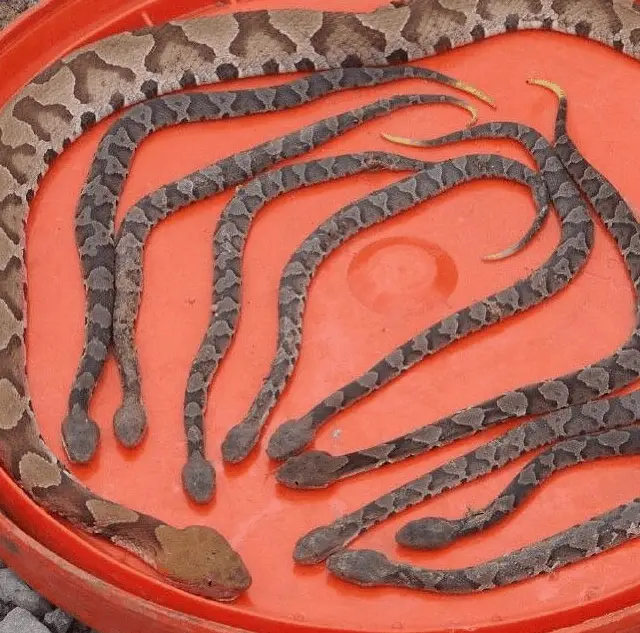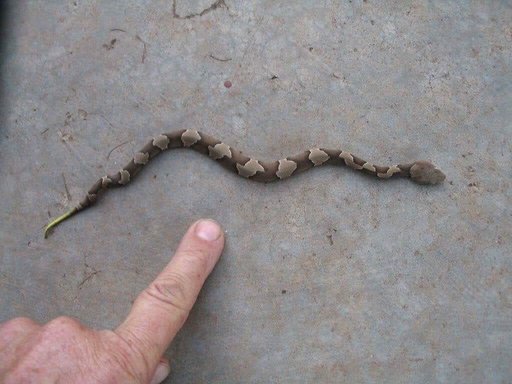There’s a lot of fear revolving around copperheads, and baby copperheads in particular. This isn’t that hard to understand considering the overwhelming majority of venomous snake bites to humans each year actually comes from copperheads.
Many snakes don’t want anything to do with people, and even venomous snakes will often go for the “run like heck” option versus threatening a human. However, that’s not always true and one of the dangers of living in certain areas are that copperheads are one of those snakes that have an “auto-strike” instinct.
This can lead to many children getting bitten by baby copperheads, so before the snake is large enough to clearly see those Hershey Kisses designs on the back, how are you supposed to know how to identify them?

So what exactly do baby copperheads look like? Baby copperheads look like the adults except they are smaller and have a bright yellow tail, and sometimes a darker head. If you see a grayish snake with a bright yellow tail and similar “Hershey’s Kiss” patterns those are almost certainly young copperheads, as well.
Table of Contents
General Copperhead Appearance
You can’t properly identify a baby copperhead from one of many lookalike snakes unless you already know how to properly ID an adult copperhead snake.
If you want the full in-depth version of how to identify a copperhead then make sure to click on that link for one of our flagship articles that deep dives into everything you need to know to be able to recognize a copperhead at a glance.
As for the short but useful list, you should memorize this short list of common copperhead traits. This will help you pick out the dangerous snakes from the lookalikes that aren’t going to harm you.
Common copperhead features:
- Tan or copper/brown coloring (gray in some young or regional cases)
- Hour glass or “Hershey’s Kiss” patterns on body
- Thicker middle
- Triangular head (indicates venom glands since copperheads are a bit viper)
- Darker coloration “tracing” outside of hourglass patterns
Any of those features can be a dead give away that the snake you’re dealing with is a copperhead.
How to Identify Baby Copperheads

Baby copperheads have many of the same traits and appearances as adults. However there are some other things to look for that can set them apart. We’ve already gone over the similarities in the previous section, so let’s now turn and focus on the differences.
Some younger copperheads tend to be more of a deep gray or dark gray color. This can be with the hourglass patterns still visible. At other times this will make them harder to see but the pattern will still be there.
Baby copperheads often have a bright yellow tail tip. This is an incredibly unique trait and that alone should make you assume the snake is indeed a venomous copperhead.
Don’t get cute with this identifying marker. If it looks faint yellow, or yellow-green, or whatever, assume it’s a copperhead. You always want to play it safe in that situation.
Also, do a little research. There are five sub-species of copperheads. A copperhead that can be found in New York State will often have a different growth rate than ones in the bayous of Louisiana or heat of central Texas. However the birthing time is generally about the same ranging from first week of August to end of September. Knowing the common breeding and birth times for these snakes in the area of the country you’re in can help you gauge the size of the snake versus whether it might be a copperhead or not.
While not quite as reliable as the other identifying marks, if the snakes are unnaturally small considering the last time copperheads should have been born (they are one of the snakes that give live birth as opposed to eggs).
That means the size of the snake versus time of the year can be another way to get an idea if the small snakes you’re looking at are baby copperheads or possibly something else.
Look at the head of the snake. If the head is a red copper color that is a pretty good sign (hey there’s a reason they got the name copperhead) and babies in particular often have two dark spots on the top of the head.
Finally, their hour-glass blotches go all the way down the side. These venomous snakes do have the ability to put venom into a bite from birth so you need to be awake and aware when they are about and about or when you’re stomping through the woods.
What You Need to Know about Baby Copperheads
So what’s the big deal? Are baby copperheads dangerous? Should you be concerned if you get bitten by one?
The answer is absolutely on both counts!
Copperheads are among the least venomous of the major venomous snakes in the United States. Most healthy adults are capable of surviving a snake bite from a copperhead even with delayed treatment or sometimes without. That’s still a terrible idea.
Elderly individuals, children, or anyone with any type of underlying health condition could end up dying from a copperhead bite. Even if they don’t, permanent damage can occur without proper anti-venom treatment.
Baby copperheads can give just as nasty a bite as their adult counterparts. Just a small list of the potential effects include:
- Puncture wounds from the fangs
- Severe redness & swelling immediately around the bite
- Severe pain starting at the bite and radiating out
- Nausea and vomiting
- Rough heavy breathing
- Blurry vision
- Feverish sweating and pain
- In extreme circumstances, death
Even with treatment there can be permanent limb damage and there will almost certainly be extreme pain. This is true whether you are bit by a baby copperhead, a juvenile copperhead, or a full grown adult.
So just how big are baby copperheads?

Baby copperheads can be very small, like the one in this picture. That’s a dangerous snake despite the fact it’s not all that much larger than a couple of average-sized adult fingers.
There could be a bunch around!
One of the most important things to understand about baby copperheads is that there tends to be groups of them when they are born. The average is around eight young copperheads but there can be as few as two or as many as fifteen.
They tend to stay as a group early on and the mother is often close by. If you see one baby copperhead, chances are there are many others around. The mother will usually stay for the first week to two weeks, while the babies will take longer to disperse.
That being said, since they all share the same habitat, when you see one or several baby copperheads around it is a very good idea to have those thick anti snake bite boots and reliable snake gaiters on.
Watch your step, and be safe out there! This goes for dealing with baby venomous snakes or adults.
How to Get Rid of Baby Copperheads
If you’re trying to learn how to identify baby copperheads then chances are pretty high you have a snake infestation you’re worried about. If you suspect that there are a lot of baby copperheads in an area where your family lives, where you work, or kids play, that is definitely something you need to take care of.
But how?
If calling pest control is an option, that is an important step. Specialists will often not only remove the venomous snakes but take a look at what environmental factors might be attracting these potentially dangerous reptiles to your property.
There are really only two main things you can do to get rid of baby copperheads:
- Remove baby copperheads (and adult ones) that are on the property
- Remove the features and habitat that will attract these snakes
If you decide that you want to remove them yourself (once again, this is STRONGLY discouraged unless you are a professional) then at least make sure you have the right protective gear and tools to minimize the risk. A bite from a copperhead of any kind is still a very serious medical situation.
Aside from the earlier aforementioned snake proof clothing like gaiters or boots you’ll want long blue jeans, thick work gloves, and of course reliable snake tongs and reptile carrying buckets that are clearly marked to prevent accidents or even tragedy.
When the snakes are removed, you need to look at changing features of the property that attract copperheads. Whether it’s taking away natural features that act as cover or getting rid of whatever is attracting their favorite food source, you need to also tackle the root of the problem to make lasting progress.
If the next fall season you don’t see any new baby copperheads then you know your property is likely safer. With this bit of education when you go out hunting or searching for morels, you’ll know what to look for to keep yourself safer in the woods, as well.
In Conclusion
The biggest thing about spotting and identifying copperheads is keeping your eyes open. Most venomous snakes are going to be timid by nature, but copperheads have an instinct to strike first before getting away.
This doesn’t mean they are overly aggressive. Copperheads will get away if they have the option.
